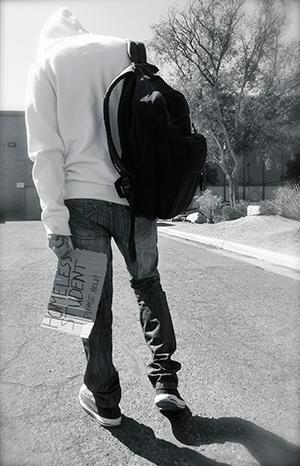
The following is the second in a series about food and housing insecurity by Leah Block, a senior majoring in interpersonal, organizational and rhetorical communication with a minor in sociology. The first article covered food insecurity and resources.
We seldom discuss student homelessness due to factors of stigma, shame and embarrassment. Popular individualist narratives of “picking oneself up by the bootstraps” (which, speaking in terms of physics, is actually impossible) contribute to negative opinions surrounding homelessness and stifle the voices of those struggling with it. The unfortunate reality is that NC State has higher rates of student homelessness than other North Carolina universities, creating an urgent situation.
Nearly 10% of NC State students reported housing insecurity in the past year. While students can help vocalize the issue to boost self- and community awareness, student homelessness should concern students and administrators alike. NC State, an institution serving young people, has an obligation to address student housing insecurity with a comprehensive plan and systematic changes.
Institutional Responsibilities
To quote NC State psychology professor Mary Haskett’s research, “Food and housing insecurity go hand in hand; 24% of students who had experienced a period of homelessness in the past year been food insecure in the past 30 days.”
I had the chance to talk to Haskett about her research and what the Wolfpack community can do about the issue of student homelessness. Haskett explained how NC State can improve both its preparedness and its responsiveness to student homelessness.
 Haskett cited the need for campus food and housing insecurity initiatives, such as Feed the Pack and Pack Meal Share, to link together as a cohesive unit. Isolated campus resources may serve fewer students and have less impact on campus. For example, food or housing resources on North Campus may not communicate as easily with different resources on South Campus.
Haskett cited the need for campus food and housing insecurity initiatives, such as Feed the Pack and Pack Meal Share, to link together as a cohesive unit. Isolated campus resources may serve fewer students and have less impact on campus. For example, food or housing resources on North Campus may not communicate as easily with different resources on South Campus.
Haskett also cites a need for the implementation of preventive rather than reactive institutional operations. Concerning student homelessness, NC State has an obligation to provide a comprehensive, preventative plan addressing the problem. This might look like a diversification of funding upfront for measures that could lead to broadened student housing availability that support students at risk of homelessness.
We should have a sense of utmost priority to address the issues of student homelessness and housing insecurity, as the problem is widespread and may exacerbate in the coming years, especially for students of marginalized identities, students from economically disadvantaged backgrounds, undocumented students and students of color. When it comes to homelessness, a few isolated resources will simply not suffice.
Stay tuned for the next article in this series, which will focus on opportunities for students to raise their consciousness as well as act on some of the most pertinent issues afflicting NC State’s student population.
- If you have not yet read this year’s common reading selection, $2.00 a Day: Living on Almost Nothing in America about food and housing insecurity and its dire consequences, check it out today.
Leah Block is a communications intern in the Office for Institutional Equity and Diversity.